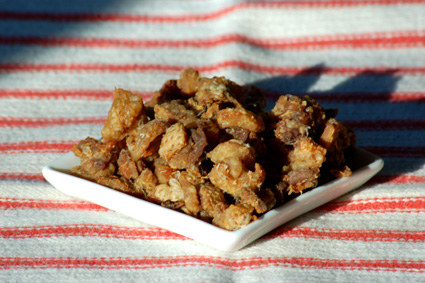There's something undeniably delicious about duck. They're not particularly meaty birds, though what you'll find on one is going to have a deep, almost red-meat-like quality to it. In fact, when I buy one, as I did the other day, I'm rarely planning something like roast duck. A chicken's easier to work with, and can feed more per pound of bird. Not to mention per dollar.
I'm pretty well convinced that the best thing about a duck is its fat. It's tasty enough on the duck, though it can be tough to render enough away during cooking to get the skin all crispy. My solution is to avoid the problem entirely. The legs become confit, which is the tastiest duck preparation I know. And not only does it taste great, but a little goes a long way, enough so that Sharon and I can happily share a single confit duck leg for dinner, using it to accent some carefully-prepared vegetables. The breasts will probably end up cured and smoked, ready to be thinly sliced alongside a cheese plate.
The rest of the bird? Well, the bones are going into stock, but that's not so exciting. But carefully trimmed of skin and fat deposits, it leaves me with:

Duck cracklings. They're the duck equivalent of pork rinds. Cut up the skin and fat, render it all down over low heat, and you're left with crispy chunks of duck skin and a significant amount of cooking fat. The duck fat - more than a cup, off of one little bird - will be used at pretty much every opportunity1. The cracklings, just sitting there on the countertop, have long since been eaten.
And though this is a bit of a digression, I must admit that I rather like pork rinds. Though I've never done anything with them remotely as cool as the pork rind reconstruction on Bent Objects.
* * * * *
1By which I mean, every time I remember I have it in the refrigerator. Since olive oil lives within arm's reach of the stove, it's pretty much default when cooking.

No comments:
Post a Comment